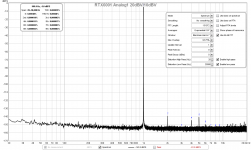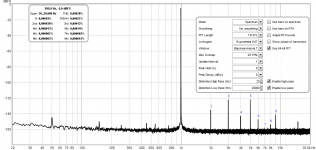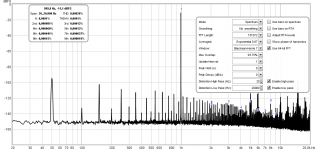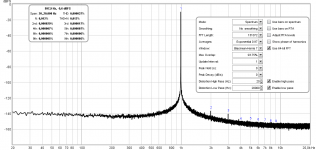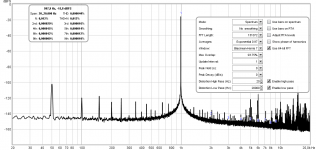Hi Gluca,
I think someone is trying to organise a group buy to see if they can get a discount. Keep your eyes on these threads to find out.
Even at their list price, from what I have seen of this unit you can't beat that price. The construction is excellent (looked at the shield mounting clips). Saving up for one of these is definitely worth while if you need a tool like this. The alternative is an Audio Precision, and that costs 4 ~ 5 times the list price here.
-Chris
Closer to 11 times the price for a APx555.
Thanks for sharing.I have to admit that THD+N measurements from Audio Tester is very tricky... Attached are the settings I used for the measurement at post #613.
Would pls indicate which Sound DLL you use.
Reason why I'm asking: I never got AudioTester working with ASIO Sound Version - no sound is send to the sound card (eg. Lynx L22, Steinberg UR12) => no measurement.
Would be great to have that sorted out before my RTX6001 arrives ,-)
Ulli
Actually, down to 0.00006% with output at -25, amp at 20dbv, and input at 1dbv.
Try 20dBV/10dBV @-15dBFS output, the THD can go further down (0.00003% in my case, -130dB)
Attachments
Thanks for sharing.
Would pls indicate which Sound DLL you use.
Reason why I'm asking: I never got AudioTester working with ASIO Sound Version - no sound is send to the sound card (eg. Lynx L22, Steinberg UR12) => no measurement.
Would be great to have that sorted out before my RTX6001 arrives ,-)
Ulli
When was the last time you updated audiotester? I had a lot of problems with an earlier version of V3 on both win 7 and XP with ASIO and audiotester, there may have been a bug.
The ASIO driver bundled with the RTX software at least in windows 10 seems rock solid, I've not had any problems with audiotester or Arta using ASIO.
I have been using a relatively old version of Audio Tester v3 (Build 20), and it worked OK for most functions, including ASIO, except for unreliable THD+N readings.
I just downloaded the latest Build 27, installed it and ASIO doesn't work properly (cannot select sample rate, and AudioTester crashes after ASIO is selected) anymore. I downgraded back to Build 20 and then everything worked as before.
It seems the build does have an impact. Unfortunately the AudioTester website does not allow downloading of earlier builds, otherwise it maybe worth to download the different builds and see which one works best for a particular PC.
I just downloaded the latest Build 27, installed it and ASIO doesn't work properly (cannot select sample rate, and AudioTester crashes after ASIO is selected) anymore. I downgraded back to Build 20 and then everything worked as before.
It seems the build does have an impact. Unfortunately the AudioTester website does not allow downloading of earlier builds, otherwise it maybe worth to download the different builds and see which one works best for a particular PC.
Last edited:
I made a quick test with AudioTester V3, RTX at my default 0dB/0dB setting, got -122dB THD @-15dBFS.
At 20dBV/10dBV setting, reached -130dB THD (output @-10dBFS).
Thanks for publishing your results. I have now tried all sorts of in / out combinations on loop back and the best I can get so far is a THD of about -123dB which is of course impressive but will keep looking as it seems quite a bit short relative to reports of e.g. -130dB.
I use V3.0d Build 27 (32) - the most recent on audioTester download page.When was the last time you updated audiotester?
Thanks for the hint
Ulli
but will keep looking as it seems quite a bit short relative to reports of e.g. -130dB.
Some observations I had:
- 44.1kHz will give lowest THD, than other sampling frequencies.
- Disabling the other channel during measurement will give a significant difference.
- My left channel is better than my right channel.
I use V3.0d Build 27 (32) - the most recent on audioTester download page.
Thanks for the hint
Ulli
Build 27 works fine in my Windows 10 notebook, but Build 20 doesn't.
Build 20 works fine in my Windows 7 PC, but Build 27 doesn't.
I think I'll just keep using REW or ARTA.
Some observations I had:
Anyway, the spec says typical of -124dB so you're very close already. And figures like -130dB are not always repeatable (I got -130dB this morning, but the 3H rise a bit in the afternoon and now I only get -129dB, or I might have damaged the generator while accidentally connecting an external generator to the RTX output port - was intending to connect it to the input for calibration)
- 44.1kHz will give lowest THD, than other sampling frequencies.
- Disabling the other channel during measurement will give a significant difference.
- My left channel is better than my right channel.
You are right that using only one channel reduces the distortion. This is related to the ADC, where one AK5394A handles both channels. If one channel has no signal, the distortion on the other channel is lower. So for very critical measurements this can be a way to get the best performance.
Does the same applies to the DAC's? If so, it might affect a two tone IMD test, where one tone is generated by 1st DAC and the other tone is generated by the 2nd DAC. A Waveterminal X192 for example, fails in this respect (more or less), as it suffer from too much nonlinear cross-talk (see also DiAna, 7th line).You are right that using only one channel reduces the distortion. This is related to the ADC, where one AK5394A handles both channels. If one channel has no signal, the distortion on the other channel is lower. So for very critical measurements this can be a way to get the best performance.
Cheers, E.
To all,
NB: The limitations on the demo version of DiAna has been relaxed a bit. Now, it's more user friendly. Please give it a try. See: DiAna, a software Distortion Analyzer
Some observations I had:
Anyway, the spec says typical of -124dB so you're very close already. And figures like -130dB are not always repeatable (I got -130dB this morning, but the 3H rise a bit in the afternoon and now I only get -129dB, or I might have damaged the generator while accidentally connecting an external generator to the RTX output port - was intending to connect it to the input for calibration)
- 44.1kHz will give lowest THD, than other sampling frequencies.
- Disabling the other channel during measurement will give a significant difference.
- My left channel is better than my right channel.
The lowest I can get is about 0.00005. How are you disabling the other channel?
My suggestion. Jensh can produce a new ADC - standalone for this purpose ( with one channel only with lowest Distortion product)!
Let us explore what we can do with RTX including software for reliable FFT with noise/distortion numbers. I am rather learning to set these different software correctly to identify the one that would be useful to my needs.
Let us explore what we can do with RTX including software for reliable FFT with noise/distortion numbers. I am rather learning to set these different software correctly to identify the one that would be useful to my needs.
Its possible to "bond" the two channels of the AK5394a together. You can even use 2 or more chips. You need a bit of DSP magic to implement this. You will get an SNR improvement and possibly some distortion improvement. Its a lot of complexity initially and the AK5394a is a pretty expensive chip to start with.
Adding a suitable notch filter will get better results and be a lot easier if what you want is measured results.
Very few audio products approach this level of performance so your entering "Distortion Nut" territory. Interesting but really not that useful. I have a "time nuts" level clock thats within something like 50 nS but its meaningless in reality to me.
Adding a suitable notch filter will get better results and be a lot easier if what you want is measured results.
Very few audio products approach this level of performance so your entering "Distortion Nut" territory. Interesting but really not that useful. I have a "time nuts" level clock thats within something like 50 nS but its meaningless in reality to me.
balanced vs. single ended
I did a few measurements to compare the use of balanced and single ended interconnections between the RTX and Victor generators, and the RTX detector. The measurements were taken first with balanced interconnects and then with single ended, without changing anything else.
The first two are using the RTX generator (i.e. loop-back) and the second two with the Victor.
Balanced is more pleasing to the eye, even if the actual THD and THD+N measures do not change dramatically.
Nevertheless, I seem to have quite a lot of common mode junk around here....
I did a few measurements to compare the use of balanced and single ended interconnections between the RTX and Victor generators, and the RTX detector. The measurements were taken first with balanced interconnects and then with single ended, without changing anything else.
The first two are using the RTX generator (i.e. loop-back) and the second two with the Victor.
Balanced is more pleasing to the eye, even if the actual THD and THD+N measures do not change dramatically.
Nevertheless, I seem to have quite a lot of common mode junk around here....
Attachments
Last edited:
- Status
- Not open for further replies.
- Home
- Group Buys
- GB for RTX6001 Audio Analyzer with AK5394A and AK4490

